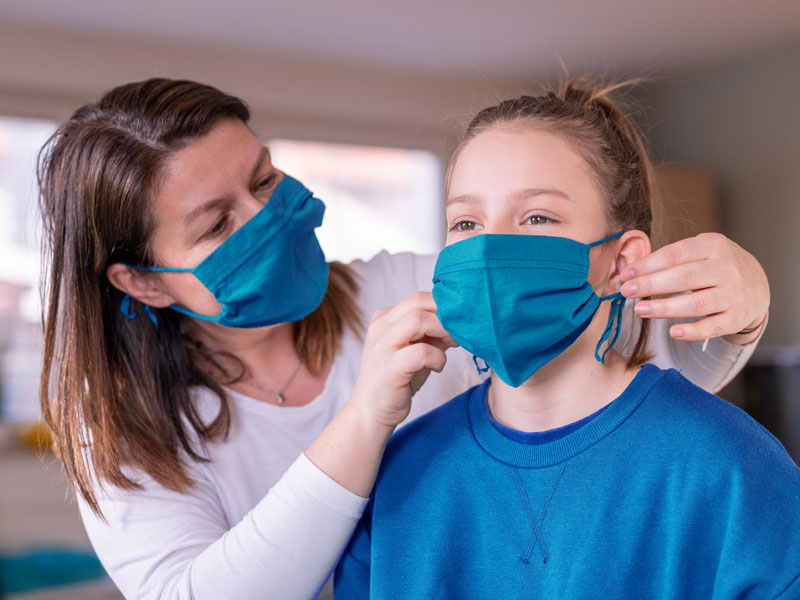As the Centers for Disease Control and Prevention (CDC) recommends mask-wearing for children over 2 years old who are not fully vaccinated against COVID-19, sometimes the challenge for kids is not only getting them to wear it but keeping the mask on their face.
Sanford Health pediatric occupational therapist Carrie Menke, MS, OTR/L, provides care for children who have difficulty with sensory processing or behavior.
The coronavirus pandemic has brought on an entirely new set of challenges to Menke’s work. Not only that, but there is increased anxiety and stress on both the child and parent with a disruption in everyday routine.
“We really had to look at our medically fragile children, accommodate and adjust,” she tells Sanford Health News. “Worries are heightened, emotional responses. Children are expressing more concerns to their parents who then contact us.”
Learn more: Latest CDC guidelines on wearing masks
Menke says some children do not tolerate well the restricted feeling of wearing a face mask.
“Some children express that they feel like that can’t breathe as well when wearing a mask,” Menke explains. “Many of us have experienced a similar sensation with different types of masks based on the fabric and thickness of material used. Some children do not like the pressure of the mask on their face. We’ve never really had to tolerate that sensation before. It has been challenging for some kids to get used to wearing a mask and tolerate it for a period of time.”
Once they’re on, keep them clean
There’s an entirely new layer to this that has to do with keeping the mask clean which, she says, has become an added challenge for families.
The CDC says masks should be washed regularly. It’s also advised that kids and adults remove them correctly and wash hands after handling or touching their mask. While wearing masks, medical experts recommend adults and children refraining from adjusting, licking, chewing and sharing their mask.
“I definitely see the kids that suck and chew and it’s just really not effective after it’s wet,” Menke said. “Depending on age, chewing on a piece of gum or a mint can provide the muscles of the mouth something to do.”
Another idea Menke suggests involves rubbing essential oil along the top of the mask which can be calming and potentially decrease any likelihood of fidgeting.
To keep your family’s masks clean:
- Wash your mask in the washing machine with regular laundry, detergent and a warm-water setting
- Wash your mask by hand with bleach intended for disinfection, safe on colored clothing
- Use a high-heat setting in the dryer or lay flat and allow for a complete dry
Coping strategies for the whole family
Menke says using play can help minimize anxiety and decrease sensory over-response while helping children get more comfortable wearing a mask. She offers some ideas below.
- Play doctor or vet with stuffed animals or family members
- Be a paleontologist — dig in play dough or kinetic sand to find hidden objects while wearing a mask
- Play dentist to clean the teeth of stuffed animals or toys
- Play spy! Plan a secret mission or scavenger hunt around the house that must be accomplished while wearing a mask
- Be a ninja — jump between cushions and practice karate moves with a mask
- Nail salon — paint one another’s nails while wearing masks
- Bug exterminator — grab a squirt gun and go outside with your mask to squirt bugs that you find
Before play begins, Menke suggests working on deep breathing.
“We know that deep breathing is the most foundational way to help calm anxieties,” she said.
Tips for parents
Menke offers up some simple advice below, she says, that could be a game-changer in your home.
It all starts with modeling the mask as parents and display a positive attitude using a slow and incremental approach.
- Start with child simply holding the mask up to their face, then loop on one ear, then over both ears.
- Wear the mask covering just the chin, then just below the nose, then in the proper position covering both mouth and nose.
- If your child is very resistant, start by having your child wear mask for a few seconds, then build up to a couple minutes, then five-minute increments. Use an activity with a concrete ending when wearing the mask, such as a puzzle, a game or a simple craft project.
- Keep the experience predictable and use repetition. Try to prevent surprises so your child feels confident and safe.
- Have a daily “Masks On!” time such as when setting the table or a specific time frame where everyone in the family puts on masks to practice mask wearing for an extended period of time.
- Can use a sticker chart to motivate masking wearing for a small reward if your child responds positively to incentive charts.
- Give options for masks to see what is a most comfortable fit for your child (i.e. different elastics, patterns, thickness of mask for breathability).
- Get creative with the style and color.
This story was originally published Oct. 13, 2020. It was updated June 10, 2021, with new CDC guidelines about wearing masks.
Learn more
- COVID-19 FAQS: Does wearing a mask affect your breathing?
- Flu shots even more important during COVID-19 pandemic
- COVID-19 Q&A: Pediatrician advice on kids and coronavirus
…
Posted In Children's, COVID-19, Expert Q&A, Frequently Asked Questions, Parenting, Rehabilitation & Therapy, Specialty Care
